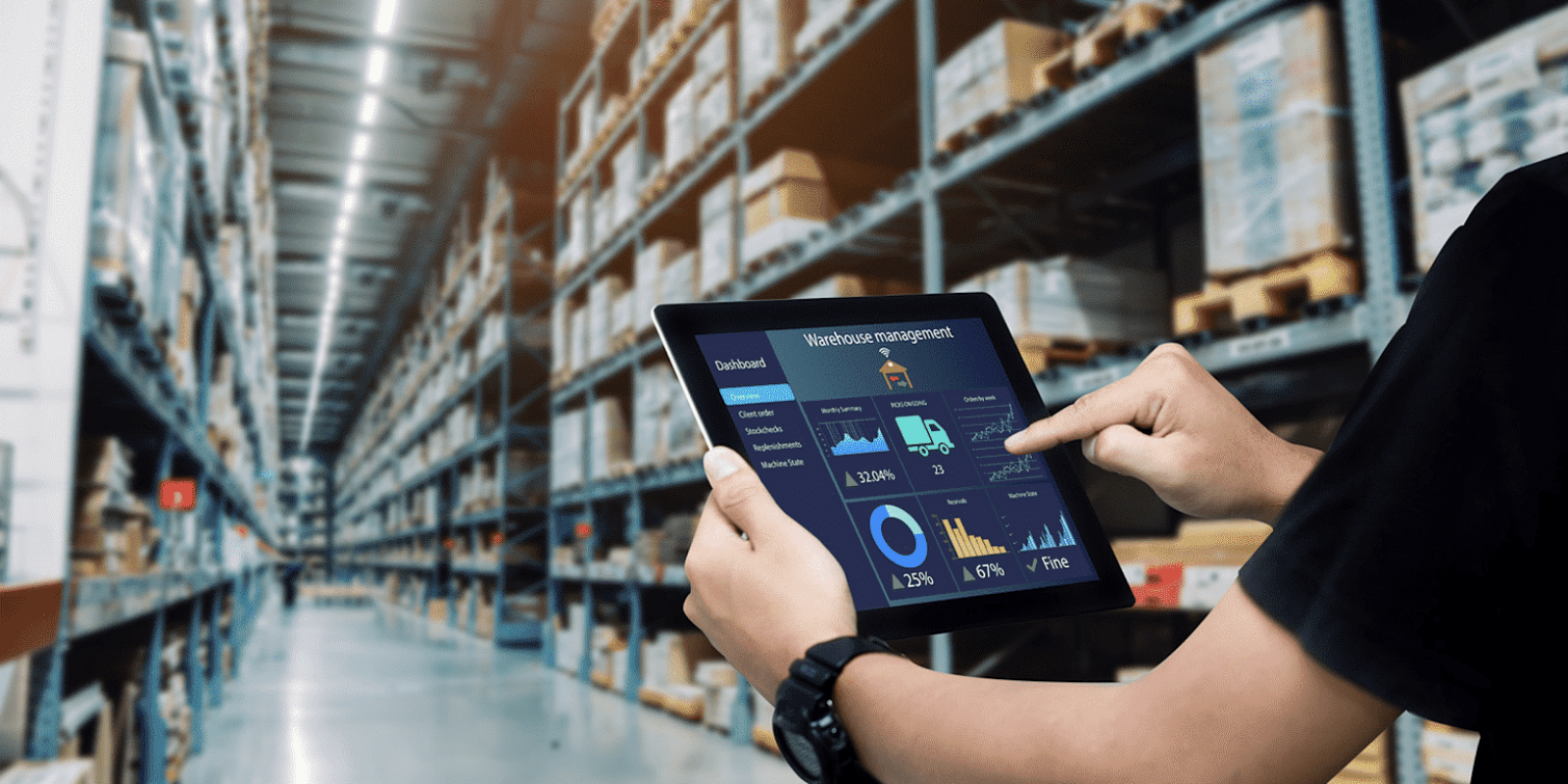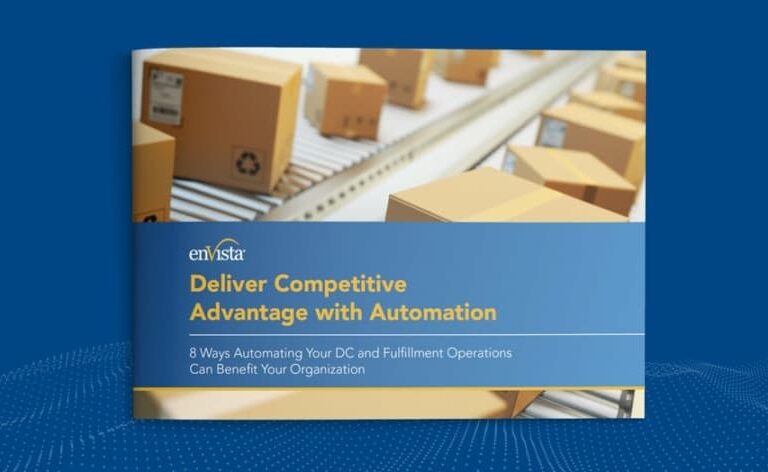With the increasing impact of technology in every industry, it is worth examining potential methods for increased efficiency, process improvements and simple evolution in the supply chain. One of those methods is warehouse automation. Warehouse and distribution center automation bring efficiency and speed to the distribution chain from the moment an order is placed to the point when the product is sent out for delivery.
Adopting certain critical enhancements will modernize the way you do business and driving long-term cost savings that make you a more valuable and trusted partner for your clients.
What Is Warehouse Automation?
Warehouse automation is a way of moving inventory into and through a warehouse with minimal human intervention. It is the result of targeted process automation in the realms of data collection, inventory control and your overarching warehouse management system (WMS). A warehouse that uses various types of automated technologies can be a crucial supply chain advantage that makes work easier to complete, conceptualize, manage and grow.
Warehouse automation shifts the burden of your most manual, repetitive, tedious and error-prone tasks to increasingly accurate and fatigue-resistant machines. This allows the human touch to focus on the most visible, value-added areas. Once properly implemented, overhead will inevitably decrease as efficiencies emerge throughout the various aspects of your bottom line. This is a true necessity given today’s tight labor market and rising labor and fulfillment costs.
The endpoint to this would be an automated warehouse that maximizes warehouse space and the activity that occurs there, driving safer and more accurate warehouse processes in addition to higher employee engagement and customer satisfaction.
How Does Warehouse Automation Work?
Warehouse automation involves the use of digital and physical automation technologies. Warehouse management systems can integrate with warehouse control systems to provide a unified approach to managing all aspects of operations.
Let’s take a look at some common technologies used in warehouse automation.
Categories of Warehouse Automation
There are two broad categories of warehouse automation: digital automation and physical automation.
Digital Automation
Digital automation typically takes manual processes like inventory data collection and digitally automates them into your software system, such as a database or enterprise resource planning (ERP) system. Instead of tracking things manually, data is digitized. This process automation can also be called warehouse automation software, digital process automation or system automation.
Elements of digital automation can include:
- Tablets and smartphones
- Wireless barcode scanners
- Software and internet networks
- Cloud databases
- Machine learning algorithms
- Data analytics platforms
These solutions are generally lower cost as they can often be straightforward upgrades to an existing system for collecting and tracking inventory. Once inventory arrives, you scan it into your WMS, where it can be tracked in real-time. An automated system can also automatically reorder items once inventory hits a predefined threshold. This supports proper inventory management, maintaining the correct stock levels and managing SKUs to ensure products are optimally placed and order fulfillment is accurate and timely.
Physical Automation
Physical automation tools, like automated guided vehicles, robotics and conveyor belts, automate routine tasks that might otherwise be time-consuming and physically demanding. Physical automation is where a real transformation can happen, as opposed to a simpler upgrade.
Components of physical automation can include:
- Goods-to-person (GTP) technology
- Conveyor belts, carousels and vertical lift systems
- Material carrying vehicles, tote shuttles and mini loaders
- Automated storage and retrieval systems (AS/RS)
- High-speed sorting equipment
- Warehouse robotics
- Driverless automatic guided vehicles (AGVs)
- Autonomous mobile robots (AMRs)
- Pick-to-light and put-to-light systems
- Voice picking and tasking
The sophistication of physical automation tools enables storage locations to use every square foot, vertically and horizontally, to their utmost ability. Advanced machinery can reach shelving unsafe for humans—further stretching capacity to another level. With improved space utilization, layout and workflow, the increase in productivity speaks for itself.
One measure of productivity, revenue per square foot, can help determine whether facilities are ready for the next step in implementing physical automation. A commitment to innovation along with a significant investment in physical automation can lead to the fully automated warehouse, where a dark warehouse is manned entirely by robots.
Common Types of Warehouse Technology
All warehouse automation technology aims to speed up processes, minimize manual tasks and reduce errors. There are many types of warehouse automation technology on the market. Here are a few of the most common types of warehouse technology that can reduce costs and l increase productivity.
- Automatic Guide Vehicles (AGVs):
Automatic guided vehicles use magnetic strips or sensors to follow a set path through the warehouse. They are useful for larger non-complex warehouses. They are not helpful in complex warehouses with a lot of human workers/traffic.
- Autonomous Mobile Robots (AMRs):
AMRs use GPS systems to find the most efficient routs through a warehouse. They employ laser guidance systems to avoid obstacles, which allows them to safely function in environments with human workers. AMRs are simple to implement and program, making them a popular type of warehouse automation technology.
- Goods-to-Person (GTP):
Goods-to-person is one of the most popular types of warehouse technology, and it includes carousels, conveyers and vertical lift systems. GTP systems are wonderful for lowering warehouse congestion and increasing overall efficacy. These systems have the potential to double or even triple warehouse picking speeds when properly implemented.
- Automated Storage and Retrieval Systems (AS/RS):
This form of GTP technology includes automated material handling systems and equipment such as tote shuttles, mini loaders and material carrying vehicles. AS/RS technology allows warehouses to retrieve and store products more quickly with less space needed.
- Voice Picking and Tasking:
Voice directed warehouse technology (also referred to as “pick-by-voice”) utilizes speech recognition software to create pick paths through a warehouse and let warehouse workers know where to pick or place materials and products. This method is a good choice to improve picker efficiency and safety, as it removes the need for manual devices, such as RF scanners.
- Put-to-Light & Pick-to-Light Systems:
These systems employ mobile barcode scanning devices, which work with light displays to guide warehouse workers to the correct placing and picking locations. These systems tend to reduce human error and the number of worker hours needed to complete tasks.
- AI and Analytics
AI and machine-learning tools can analyze data in real time, helping warehouse managers optimize inventory levels, predict product demand trends and make strategic decisions.
- RFID Technology
RFID tools accurately track the location of goods, which helps humans and robots locate them and log their movements throughout the warehouse. Using RFID systems to track and manage inventory helps reduce the likelihood of human error.
Benefits of Warehouse Automation
There are many benefits to warehouse automation, including:
- Warehouse space: Warehouse automation can improve space utilization in the warehouse, ensuring no space goes to waste.
- Inventory and shipping: The automation of simple and tedious tasks can significantly reduce incidents of human error.
- Productivity and accuracy: Warehouse automation increases the speed at which certain tasks can be completed.
- Operational costs: Higher efficiency and accuracy reduces costs across all areas of the warehouse, including shipping, operations and labor and handling costs.
- Employee satisfaction and safety: Warehouse automation can take on tedious and dangerous tasks, freeing up employees to focus on more rewarding and safer roles.
- Resource and material handling: Automation streamlines the movement and management of materials in your warehouse, leading to more efficient and organized warehouse operations.
What Parts of the Warehouse Can be Automated?
With the right equipment and software, many parts of warehouse operations can be automated, including:
- Picking: Robots can handle picking in many warehouse environments, working safely alongside humans to manage order fulfillment.
- Replenishment: Using warehouse automation software to manage stock levels and robots to move products can improve stock replenishment efficiency.
- Quality checks: Automatic quality checks at various stages of the warehouse process can improve customer satisfaction and help identify areas for improvement.
- Cross-docking: With more efficient inventory management and demand forecasting cross-docking becomes possible, shortening the handling and storage time required and maximizing the use of warehouse space.
How Do You Automate a Warehouse?
The right warehouse automation solution depends on your specific objectives and budget commitment. Due to its higher upfront costs, physical automation may only yield adequate ROI for larger distribution centers and high-volume warehouse operations. Because it directly improves upon existing processes, consider starting by evaluating which aspects of digital automation to adopt and then expand from there.
More generally, you should begin with a representative sample of internal stakeholders who have expertise in current warehouse performance, capabilities and challenges as well as an understanding of existing technology gaps. They will create the initial vision of the present situation and evaluate how you currently collect data and control inventory. At this stage, key performance indicators (KPIs) are established to evaluate the impact of the automated warehouse. From this point on, you can start to implement your warehouse management system (WMS) to start monitoring progress as it occurs. Many businesses choose to work with a vendor during this process to benefit from their experience, expertise and increased efficiency.
As the WMS is rolled out and you have data to measure, you can start to envision how far and in what direction warehouse automation will take you. As a best practice throughout these steps, you will want to gather frontline employee feedback to gauge less obvious objectives or overlooked sentiments toward the changes.
Warehouse Automation Best Practices
Some best practices for implementing warehouse automation systems include:
- Training: Conduct a dedicated training and change management process to ensure everyone in the warehouse is aware of the new systems, why they were implemented and how they work.
- Employee motivation: Provide incentives to improve employee motivation and set achievable KPIs based on the new systems.
- Perform continuous cycle counts: Focus on small batches to maintain accuracy. Identify high-value items for ongoing monitoring and perform full cycle counts as often as possible.
- Evaluate warehouse design: When implementing warehouse automation, take the opportunity to evaluate your warehouse design, including layout and SKU placement, to ensure everything is optimized.
- Automate data collection: Automate data collection to improve the accuracy and currency of your warehouse data.
How Much Does It Cost to Automate a Warehouse?
The cost of an automated warehouse depends greatly upon your company’s specific needs. The scale of automation can vary extensively, with a full overhaul of an existing infrastructure costing upwards of $50 million. Be sure to complete a thorough calculation of cost, return on investment (ROI) and the downstream benefits (customer satisfaction, lower overhead, etc.) of automation.
Estimates suggest that a fully automated solution costs at least $25 million, while a semi-automated solution is about $5-$15 million. A more mechanized approach costs approximately between $1 million to $5 million. Automation that focuses on manual picking activities would be between $500,000 and $1 million. These costs are significant and require careful consideration, but the impact of such moves could be the difference between mere survival and prosperity in an unprecedented retail and supply chain environment.
How enVista Can Help
Once you recognize the transformational gains of automation in the warehouse, the next step is to create a strategy with actionable steps.
enVista’s warehouse automation consultants can advise you on how to implement digital and physical automation processes to bring the greatest benefit to your business, improving your material handling and boosting your efficiency. We offer a range of automation options, including SLAM line automation technology, to help you better manage every aspect of inventory management and order fulfillment.
Ready to optimize your warehouse? Let’s have a conversation. ®






